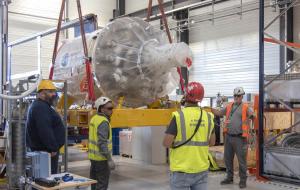First unit reaches ITER
The ITER vacuum team, the European Domestic Agency Fusion for Energy, Research Instruments (RI), and the ITER Director-General were all excited to welcome the delivery of the ITER first production cryopump on 30 May.
"This delivery is the first of 8 units to roll off the industrial production line with cryopumps now set to arrive at ITER at a rate of one per month," says Robert Pearce, ITER Vacuum System Project Leader. "This delivery achieves an iconic ITER milestone, the culmination of much innovative and challenging work collaboratively performed by the ITER team, including the European Domestic Agency, European industry and associations."
The torus and cryostat cryopumps are among the most complex components to be designed and manufactured for ITER. Operating at temperatures as low as 4.5 K and as high as 200° C, they contain precision mechanics with moving parts that form the world's largest all-metal vacuum valve. The cryopumps will safely pump and confine the fusion exhaust of helium, tritium and deuterium as well as provide insulating vacuum in the ITER cryostat.
ITER completed the build-to-print design of the pumps in 2017, after building the pre-production cryopump. Constant effort and attention to detail were required to successfully manufacture these pumps. Challenges during manufacturing included damage to components due to flash flooding from severe storms in Germany, the Covid-19 pandemic, and the need to develop a new adhesion method for the cryopump coconut charcoal after corrosive chlorine was found in the previously used glue.
The pumps were initially planned to be installed for a first plasma in 2025, however it will be a few years before the vacuum vessels divertor ports are ready to receive the pumps. In the meantime a cryopump test facility is being built within the ITER cryoplant, allowing each pump to be tested in advance at cold temperatures (4.5 K) and for ITER's pumping scenarios, ultimately saving significant amounts of time during commissioning.
Many people have worked on the cryopumps over the last 20 years or so; even Director-General Pietro Barabaschi recalls doing an analysis back in ITER's Engineering Design Activities days. As such, this delivery is akin to the joyous arrival of a heathy baby—it's just that this baby has many proud parents who have contributed from conception through R&D, design, qualification and manufacturing through to this momentous delivery!
See a related story on the Fusion for Energy website.



